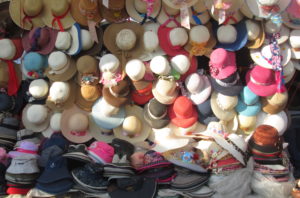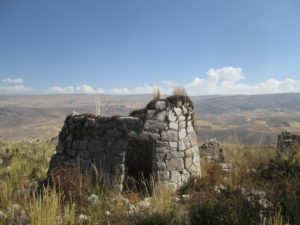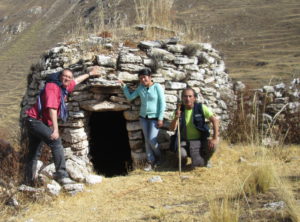My first morning in Jauja, I needed a hat to shade me from the sun. To my surprise, I found a store just outside the hotel – “Specialista en sombreros de todos partes”. hatshats hats
Walking the streets in my new black Trilby I saw now that everybody in Hauja had a hat, and some had several. There were leathery old market women with turret shaped pale blue w oollen hats perched atop their grey hair, babies strapped to their mother backs’ cocooned in tiger and monkey face hats, complete with ears, and children in prams with pink ribboned bonnets; boys and girls walking home from school in giggling groups sported red cloth sunhats, and there were even women wearing two or three hats, perched on on top of another. Many market stalls sold hats, and several specialised in particular types of hat, whilst in alleys and dark workshops at the roadside there were hat repair shops, hat wholesalers – high stacks of woven Panamas or canvas cowboy hats wrapped in plastic. I imagined somewhere there would be hat stylists, designers, PR executives and consultants.
oollen hats perched atop their grey hair, babies strapped to their mother backs’ cocooned in tiger and monkey face hats, complete with ears, and children in prams with pink ribboned bonnets; boys and girls walking home from school in giggling groups sported red cloth sunhats, and there were even women wearing two or three hats, perched on on top of another. Many market stalls sold hats, and several specialised in particular types of hat, whilst in alleys and dark workshops at the roadside there were hat repair shops, hat wholesalers – high stacks of woven Panamas or canvas cowboy hats wrapped in plastic. I imagined somewhere there would be hat stylists, designers, PR executives and consultants.
 oollen hats perched atop their grey hair, babies strapped to their mother backs’ cocooned in tiger and monkey face hats, complete with ears, and children in prams with pink ribboned bonnets; boys and girls walking home from school in giggling groups sported red cloth sunhats, and there were even women wearing two or three hats, perched on on top of another. Many market stalls sold hats, and several specialised in particular types of hat, whilst in alleys and dark workshops at the roadside there were hat repair shops, hat wholesalers – high stacks of woven Panamas or canvas cowboy hats wrapped in plastic. I imagined somewhere there would be hat stylists, designers, PR executives and consultants.
oollen hats perched atop their grey hair, babies strapped to their mother backs’ cocooned in tiger and monkey face hats, complete with ears, and children in prams with pink ribboned bonnets; boys and girls walking home from school in giggling groups sported red cloth sunhats, and there were even women wearing two or three hats, perched on on top of another. Many market stalls sold hats, and several specialised in particular types of hat, whilst in alleys and dark workshops at the roadside there were hat repair shops, hat wholesalers – high stacks of woven Panamas or canvas cowboy hats wrapped in plastic. I imagined somewhere there would be hat stylists, designers, PR executives and consultants.On a previous visit to nearby Huancayo I had seen a tourist office in the shape of a hat, with pigtails reaching down behind to the ground, and in the Huanca Garden of Identity, Parque de la Identidad Huancayo, the repeated motif of hats and pigtails which entered the earth and became roots.
But Jauja is not Huancayo. Though they are barely 55 km apart, both were centres of civilisation in the fertile Mantaro Valley long before the Incas, or the Cusqueños as they are called here, the invaders from the South. They are thought to have moved to the Central Sierra from the rainforest to the East, about 12000 years ago. In steep valleys near Jauja are remains of ceremonial centres, stone tools, necklaces of shell, and clay figurines. The Jaujas and the Huancas whose ruined settlements can be seen on the surrounding hilltops were very similar yet different. According to traditional history, the Huanca men wore a headband of black whilst the Jauja men wore a red heaband.
A taxi driver in Lima explained to me weeks later, when I asked if Huanca and Hauja people were different, “Jauja people are terrible. Lying, thieving, corrupt, dirty…” He came from Huancayo.
Some 300, 000 people, or 10% of the population of Peru, now speak Huanca, or Quechua Huanca. Shausha Quechua in turn is another language.

I asked Enoch Espejo, retired school teacher and now an indefatigable explorer, researcher and photographer of local history and traditions, what the hats meant today.
“Up to 20 or 30 years ago, the Huanca people wore a type of black hat with a black ribbon, and a black skirt. The Sausa women wore a special type of white hat. There was a time you could tell where people came from by the hats and skirts they wore. But now everybody wears trousers.”
He pointed to a women acrossing the market – “that black hat is a Huanca hat – I’ll show you a Jauja hat in a while”
According to some historians, there were different groups of Huanca, with different dialects of the Huanca language. They controlled the valley and built large cities and roads, for perhaps 200 years before the Incas expanded Northwards and conquered them.
The historic central city of the Jauja was on a hillside a few kilometres North. On the ground today is a complex network of round structures linked by narrow streets, with some lower storage rooms, and lots of connecting and dividing walls, all built of stone blocks. The round buildings are particularly fine, with stones shaped both to curve around the building and taper to the top, with tightly fitting large blocks used on the outside , whilst within the finish is more rough-hewn. The doorways are made of well squared and matched blocks tapering to a single lintel – the antecedents of classic Inca trapezoidal stone work.
Within three encircling walls is a city divided into two symmetrical sides by a broad open corridor and a central plaza, so that in plan it resembles a giant butterfly. Ceramic fragments are everywhere. A few fine green granite grinding stones for maize or corn are also scattered amongst the ruins or built into the wallsas broken fragments.
So as the sun was setting I descended the rocky hillside and crossed a freshly plowed field of red earth to reach the road, where a gang of potato harvesters were labouring late. An hour’s walk took a square in the village of Tunanmarca, where I was told a bus would come in ten minutes. An old woman dressed in a broad blue skirt, grey woollen leggings, a pink shawl and a blue woollen hat herded 100 sheep through the square. There were three parked motorbikes but no ca rs. On one corner a cow had its head and shoulders inside the front door of a house. A puppy dog gambolled over to inspect me, followed by its smartly dressed young lady owner who bid me good afternoon: a dirty old dog trailing after a dirty old man, a leathered farmer directing two donkeys with a stick, and finally the bus.
rs. On one corner a cow had its head and shoulders inside the front door of a house. A puppy dog gambolled over to inspect me, followed by its smartly dressed young lady owner who bid me good afternoon: a dirty old dog trailing after a dirty old man, a leathered farmer directing two donkeys with a stick, and finally the bus.
 rs. On one corner a cow had its head and shoulders inside the front door of a house. A puppy dog gambolled over to inspect me, followed by its smartly dressed young lady owner who bid me good afternoon: a dirty old dog trailing after a dirty old man, a leathered farmer directing two donkeys with a stick, and finally the bus.
rs. On one corner a cow had its head and shoulders inside the front door of a house. A puppy dog gambolled over to inspect me, followed by its smartly dressed young lady owner who bid me good afternoon: a dirty old dog trailing after a dirty old man, a leathered farmer directing two donkeys with a stick, and finally the bus.The bus came to a halt in the next square. Before us were 100 dancers, turning and gesturing in a slow stately formal performance to an orchestra playing Andean harp, violins, clarinets and saxophones. This then was the Tunantada – the town, and the ruins above, were called TunanMarca, place of the Tunan, and the Tunantada was the regional dance, illustrated on the walls of every restaurant, performed in the background to every Junin region music video, and declared Cultural Patrimonio de la Nation, part of the National Heritage.
In the centre were women in brightly multilayered skirts, stiff brocade shawls with colourful and intricate embrodiery, behind them were gentlemen with tall feathered hats, a walking stick held aloft in one hand. The men rotated slowly, noses in the air, waving their stick imperiously. Another group of men wore face masks. They could be old whitefaced men with white hair and beards, but at the same time they were obviously cuy, hamsters, the furry rodents domesticated in many andean households to provide meat on special ocasions.
In the 2016 presidential elections candidate and eventual winner Pedro Pable Kuchynski – known to everyone as PPK – was accompanied on the campaign by a giant dancing hamster in party colours, known to everyone as PPCuy. Andean zoomorphology lives on.
Many dancing men smoked pipes. They wore embroidered trousers to the knee, and leather boots. And circling the group was an ominous figure in a black cape with tall black boots, with a coiled whip in his hand.
Though each village in the region performs the dance at different times and have different versions, the theme is essentially the same. There are from five to twelve characters, representing different people in Colonial society from the Spaniard through his local, indigenous overlord (with the boots, cape and whip) to the doctor, the mule handler, the indian and the slave.
At the side of the square were stalls selling picarones, chicharron, and beer. I met Dennis, an accountant from Lima, born in the village, who came back every year on 25th July to see his grand-parents and perform in the dance.
“It is a skit on the Spanish, their manners: the dancers represent the different classes of society. But it is a joke, because we are all the same; you breathe, I breathe, we all breathe, we all die, and when we die the riches, the Audi and the BMW mean nothing.”
“its like Miraflores and San Isidro, [two enclaves in the upper class prison that is central Lima] those people don’t perform this dance, they have their noses in the air but they are the same.”
The women in their gorgeous costumes, often with face masks with blue eyes and white skin, represented, I discovered, local women who had become lovers of the Spanish. The spaniard was el Capitane or el Principe. And in a modern day touch, one of the prancing characters was decked in a dark suit and tie, carried a briefcase, and wore the red and white sash of a Congressman.
I spent a day exploring with Enoch, together with Mari, and Victor. Mari was a small slightly built girl with a shy voice who at first I took to be a school girl. In fact she was an infant school teacher. I did not ask her age, but I discovered her father was over 80 with failing eyesight and hearing. She told me Enoch – “the professor” – was one of the few people who still knew how to dance the Huatrilla correctly, “its not just the steps, you have to feel it.”
This was one of the several characters in the Tunantada dance-play. She herself danced the role of “my father taught me how to dance this at home, it is a dance for men”.
We climbed a hillside to see Puya Raimondi in flower. We sat under the shade of a stand of pine trees for lunch. Victor had brought a fresh cheese from his village, half an hour outside Jauja, and some chirimoya, soursops, the size of apricots, quite unlike the baseball sized offerings in Lima. These are sweeter” said Victor, “I don’t like the bigger fruit.”
Victor was an artist and had brought his sketchbook,struggling to convey the complex leaves and flowers of the giant puya raimondi, something like a ball of spikes grown 4 metres tall, from which after 100 years, a giant flower stalk shoots up, in a matter of months, a further four metres, before opening its maize cob like buds to reveal blue and white flowers. Hundreds of bees buzzed around, and a giant hummingbird flew intermittently past to feed.
We had all brought bananas, three different varieties between the four of us. They told me of eight or ten varieties available in the open market – the borders of the amazon rainforest are just a few hours away.
Victor saiud that with potatoes, as with fruit, the small knobbly papas nativas – several thousand varieties – were tastier than the big white round tubers sold to the city.
“All our main crops in the village are grown to be sold outside, and they spray them three or four times. They even spray them after digging them up, to fix the colour. “
“But we grow our own potatoes to eat in a different field, and we grow the small native potatoes. They tast better and we only spray them once. “
He knew a friend in a sheltered valley growing strawberries at 4000 metres.

In the centre of town is a pool hall called Las Vegas. A cast iron fence at the front was pierced by a gateway leading over a wooden slat bridge to a tiled patio, fronted with wooden pillars and a turned wood balcony. Nine separate rooms house nine full size pool tables, and a rack of cues and chalks stands at the entrance. It was full of teenage boys, who played quietly and seriously. I was the only one drinking beer.
Jauja also has its own special bread, small round flat breads that come in several flavours – bolle, anise, what makes them special is that they are made of wholemeal flour, and are full of texture and flavour. The town has several good cevicherias, although six hours from the sea. But best of all is the fresh trout – I ate a large whole trout with potatoes and spicy salsa at a stall by the side of the weekly Wednesday market, Huge slabs of beef and pork hang in the butchers.
On the hillsides above the valley are many Colcas, lines of circular builldings up to 3 metre high and 3 metres wide. They once held dried foodstuffs such as maize, potatoes, chacri (dried meat) as well as clothing and footwear. There are 20 to 30 of these on the nearest hillside to Jauja, around and beyond the hilltop cross reached by 360 steps from the edge of town. Others are visible across the valley. They were positioned on the hillside above town, it is said, where the temperature was cooler and winds would help keep the produce dry. Archaeologists count 80 such sets of warehouses in the valley.
And so it was the the invading Sapanish came to establish their first settalement here, They could live for years on the accumulated Incas budget surplus, were in a fertile well watered valley with a pleasant climate, and amongst allies, for the Sausa and Huancas were quick to see an opportunity to free themselves from Inca rule. Early writers spoke of this paradise full of fruit, livestock, fish and fertile farmland. The Spanish invaders moved to Lima later, when they had conquered the territory and changed the emphasis to shipping the stolen gold and silver back to Spain via Panama.
We visited a settlement of the Jaujas, on a high cliff above the River Montaro, well constructed beehive huts made of flat limestone blocks, neatly shaped and trimmed to size in the lintel doorways, and meeting in the centre to form a roof of overlapping rocks – many still had intact roofs, whilst the walls still stood 3 or 4 metres high, after 800 years. There were ceramic fragments on the ground, a couple, tan coloured, bore a grey-black zigzag pattern which Enoch said was characteristic of Jauja creamware. Tucked between the roofing stones on one beehive was a sliver of rosy quartz shaped into a fine cutting tool. Sheep, with red ribbons in their ears, grazed amongst the fallen walls. Some of the ancient huts were clearly being used by the shepherds. Inside several were beds of fresh straw, whilst one had a hand-brushed tucked amongst the ceiling stones.
A kilometre further, walking through fields of stubble wheat, a fissure opened up in the ground beside us and became deeper and wider until we were skirting a great eroded canyon with limestone walls. We walked precariously down through narrowing winding paths to its grassy floor: polished marble boulders spoke of a seasonal flowing steam. And on the back wall of a rock shelter were faded ochre imprints – many llamas, spirals, sun motifs, and possibly human figures. The images were smeared and ambiguous, – and could that red smear be a pre-historic hat?
